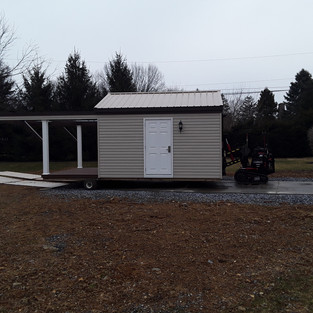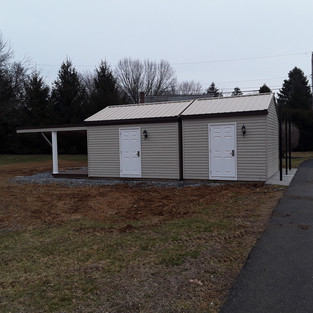When I first got started with astronomy over a decade ago, I had recently been hired as an astronomy teacher and planetarium director at the school I continue to work at to this day.

My predecessor had purchased an 8"Meade LX10 Schmidt-Cassegrain telescope for use for the astronomy class and planetarium events. The telescope was mounted on a dual fork mount, and was driven by a "clock" style motor with a push button directional pad hand controller for fine centering and guiding control. The telescope was mount was placed on top of a wedge, providing the ability to track the night sky throughout a night of observing. The "tripod" was literally made of 2"x 4" wood with bolts holding the whole thing together. I spent some money getting wing-nuts and painted it black (image right).
This telescope was amazing to me, as it was the first one I had ever used, and I quickly fell deeply in love with observational astronomy. The school had previously had an astronomy club, and the administration were very interested in getting the club started again when I approached them with an interest in being the school's astronomy club advisor.
I really started to get the bug the first time I ever traveled to Cherry Springs State Park in Coudersport, PA in fall of 2011 for the Cherry Springs Star Party. The amazing people and the telescopes I got to look through while attending the Cherry Springs Star Party, like this enormous dobsonian, at the changed my brain forever. I will never forget the kindness of the gentleman who spent his night helping the novice telescope operator learn his way around the star filled Bortle Class 1 skies of Cherry Springs.

Want to learn more about Cherry Springs State Park?
Cherry Springs is a Certified Dark Skies from the International Astronomical Union (IAU). (Check out my video to the 2019 Black Forest Star Party Below)
By 2012 my club students and I had hosted our first ever public observing event, the 2012 Transit of Venus, and I was hooked on conducting public outreach. I wanted to share my experience with as many people as I possibly could. Space was so accessible, and I was learning how I could use my skills as an educator and planetarium director just one step closer for those in my local community.

Joining a Local Astronomy Club
In 2012 I joined the Astronomy Enthusiasts of Lancaster County (AELC), a local club and a member of the NASA Night Sky Network. If you are not yet part of an astronomy club, and have never heard of the night sky network, I highly encourage you to check out this website to learn more about what is happening in your neck of the woods.

Astronomy Public Outreach
After a few months of being an AELC member, I was asked if I wanted to be president of the club. I was a bit shocked, but I made it contingent upon some of the other officers in the club staying with me. They agreed, and for the next six years I was president of the club.
Throughout that experience myself with significant help from my fellow veteran astronomer officers and our club outreach team members doubled down on our "star watch" agenda, helping to organize large gatherings at local parks, and sharing the universe with the attendees at these events in addition to telescope training sessions for people to bring their telescopes in for a live Q&A with our outreach team. The program was a huge success, helping dozens of families experience the night sky for the first time.
Image Gallery Credit: Joey Ulrich (Thanks for documenting this and for the permission Joey!)
Down the Rabbit Hole- Astrophotography
Throughout the process of doing these star watches, I started to get really interested in the photography I saw others around me creating. Astrophotography was extremely exciting for me, and I bought my first ever DSLR, a Canon T3i. I had read the reviews, and it seemed that this camera was likely to be my best value at the time of purchase, circa 2015. Around the same time, I had a group of students also interested in astrophotography. Together with these amazing young minds, we ran student-created, student operated, and student-presented public planetarium shows as fundraisers, and we were able to purchase our first Equatorial telescope mount, a Celestron CG-5. My students and I were extremely excited for the new Go-To capability, and we de-forked the Meade LX-10. We immediately hit a TON of issues regarding the extremely long focal lengths associated with imaging through a Schmidt Cassegrain.

Within a year, myself and students had written a grant to purchase astrophotography equipment. We were on our way! But wait a second. I didn't have a clue how to do any of this stuff... now comes the hard part. Learning how to take an image of the night sky through a telescope, and then the even harder part, processing that image.
I struggled through many of the early stages of problems. Tracking, Guiding, and Periodic Error Correction. I spent an entire summer trying to get guiding issues resolved, but ended up hitting issues with tracking that after much banging my head against a wall, I realized were the result of mount gearing issues that were so severe it was simply a lost cause. It was at this moment that my frustration was at it's peak, and I decided that it was time to be honest with myself as to what was possible without upgrading the mount.
The Observatory Project Dream
In the following year, I made my first 3D diagrams of my vision for a future dream observatory on my school's campus. I spent many hours researching the various types of observatories possible, and finally settled on the "roll-off-roof" style observatory as the best possible solution. My hope was to bring to my students the most "push button" way of getting the results we wanted without all of the headaches of setting up a telescope. In the end, I wanted the science to be the primary learning experience. This goal was very much pie in the sky, and I never dreamed it was possible.
However, after many years of design iterations and changes in potential locations for the structure, my school will have their observatory. After much searching for designs I ended up finding a local shed company that already produced a "sky shed" that was a very good design. We went through a lengthy approval process, got proper engineered diagrams drawn up, and brought the building up to spec for code. The project had taken a life of it's own, and the support of my school and local community has been outstanding. Additionally, the financial support of our local businesses and education foundation were integral for the funding of the project, which was completely grant-funded. At this point in time, we are about 90% of the way through the project. Below are a number of images of the project thus far.
The observatory includes two separate piers, with "Pier 1" including a Losmandy G11T Go-To Telescope Mount with a Stellarvue SVX152T Premier Apochromatic Refractor. It will be placed on a Pier-tech 2 Automated Pier System (Raises and lowers by over 30"). "Pier 2" is mostly for the purpose of future expansion and will also be on a Pier-Tech 2 Automated Pier System. There are TWO buildings in the final design, one being the observatory itself, while the other is the dedicated warm room that will be climate controlled and include the computers, desks and seating, and the ability to monitor images while on-site. The eventual plan is the have the facility also be completely remote-capable and be able to conduct automated imaging runs for the purpose of scientific study for my classroom activities.
A Wrench in the Observatory Project's Gears
As of the time of this blog post in June, 2020, the observatory project is coming along very well. Unfortunately, due to COVID-19, all progress on the project had to come to a halt.
I cannot wait to get the project finished so I can bring the universe to my local community. I plan to spend the next 23+ years of my life helping students to realize that, in the words of a friend of mine, "the sky is not the limit, it's only the beginning" - Adam Toder
(Adam is an awesome astrophotographer can can be found @spacedoutpics on Instagram)

Cosmos Safari Beginnings
Around the time I was wrapping up the planning for the observatory project, I started to get bored. In 2018 I had stepped down from my position as President of the local astronomy club in order to focus more on family. I needed to get more astronomy back in my life.
Over the last few decades, I had been Inspired by Trevor Jones from AstroBackyard. He and I had met in 2017, and through my discussions with him over the years he encouraged me to Start CosmosSafari.com. Trevor is one of my big influences for this channel in his ability to tell a story and bring you, his audience along for the ride. Below is my interview of Trevor that represents one of the first videos on this channel.
As a result, in January of 2020, I started Cosmos Safari. All of my early work can be found mostly on YouTube, and starting with the global shutdown in March of 2020, I started to spend more of my time considering how CosmosSafari.com could help me connect with you, the astronomy community online. I hope to bring my personal passion of astronomy to Cosmos Safari through educational information, but also through telling you my story as I learn more about this wonderful mutal hobby of ours. I hope you join me.
I have some really amazing stuff coming your way soon, and am in the process of bringing Astrophotography and my passion for teaching to the online world. Please consider subscribing to this blog at the bottom of your page. Please also consider following Cosmos Safari on my YouTube Channel, Facebook, Twitter, Instagram, and TikTok accounts. If you are interested in more of the LIVE video format and to speak with me directly, consider heading over to my Twitch Channel. If you would like to directly support this blog and Cosmos Safari, I would truly appreciate your patronage through my Patreon account.








































































Comments